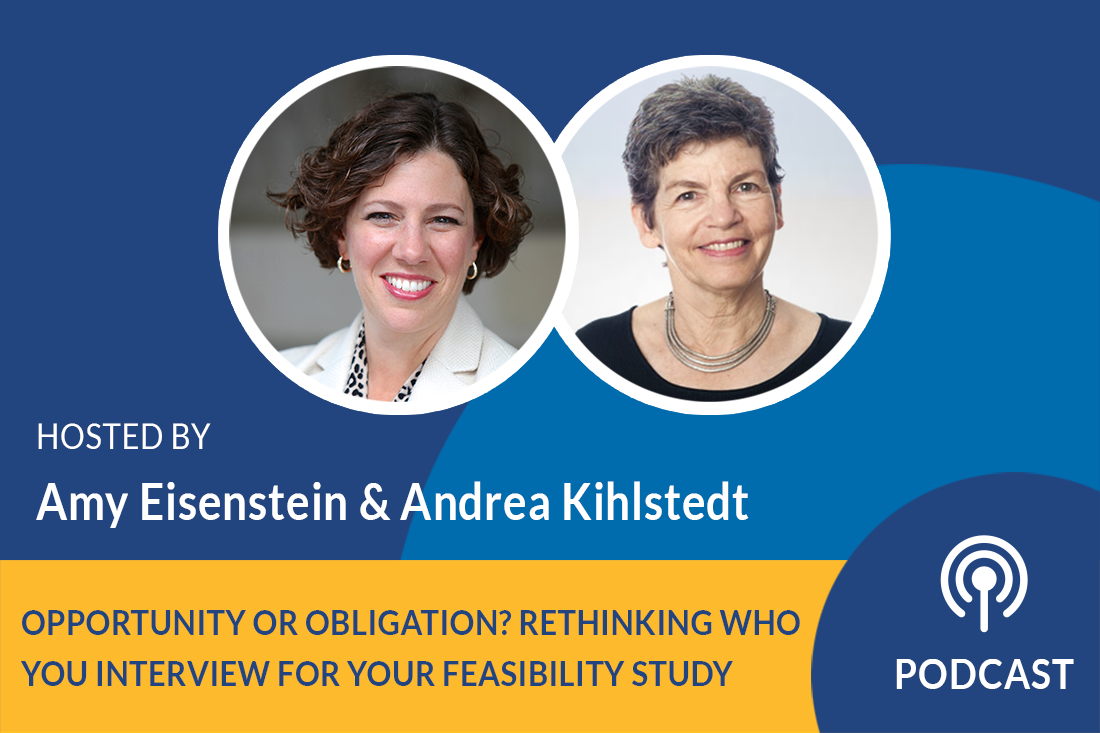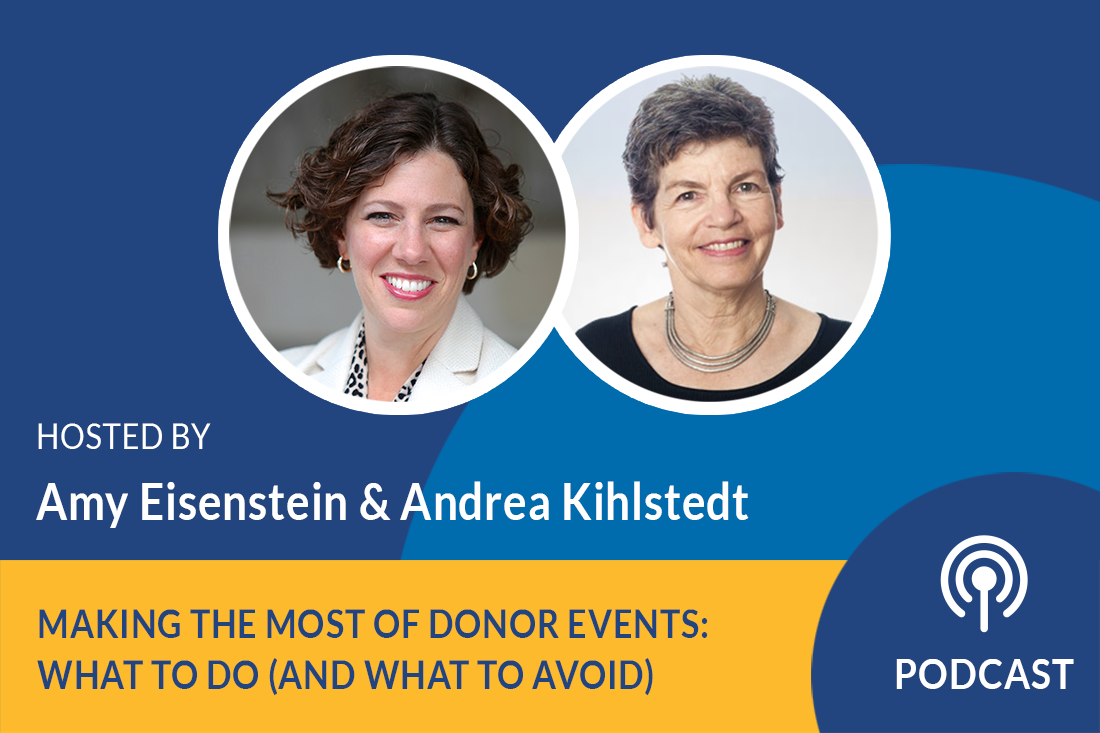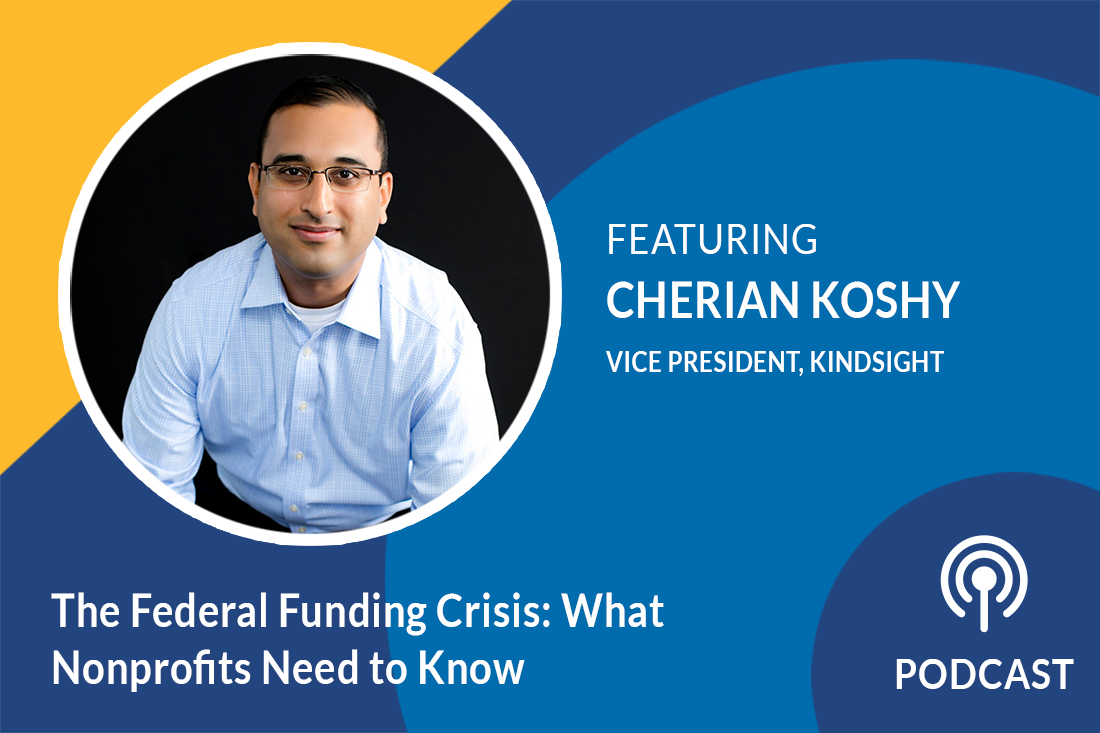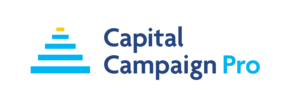Podcast: Opportunity or Obligation? Rethinking Who You Interview for Your Feasibility Study

Season 4, Episode 34
In this episode, hosts Amy Eisenstein and Andrea Kihlstedt challenge the common mindset around feasibility study interviews and make a compelling case for expanding the list beyond your current top donors.
They break down why feasibility study interviews are not just about assessing campaign readiness but also serve as a powerful tool to build relationships, raise sights, and gather community feedback. This episode offers multiple frameworks for deciding who should be included in your interviews—ranging from concentric circles of connection to categories of influence and gift potential.
Listen Now:
Stream the episode above, or click here to find it on Spotify. You can also find all episodes on your favorite streaming platform.
Andrea Kihlstedt:
Sometimes people confuse the idea of something being a necessity or something being an opportunity. And today we have a story and a lesson for you about that.
Amy Eisenstein:
Hi. I am Amy Eisenstein. I’m here with my colleague and co-founder, Andrea Kihlstedt, and today we’re going to be talking about the difference between opportunity and necessity and whether you can see the difference.
Feasibility Study Interviews: Confusing Necessity for Opportunity
All right, Andrea, get us started. Tell us what happened yesterday in a client or a prospective client call.
Andrea Kihlstedt:
Yeah. This is a fresh story on my mind. It really hit me like a ton of bricks. So I was talking to a prospective client and suggesting to them that while they knew they had 12 or 14 people they should interview in a feasibility study, I was suggesting that they probably should think about interviewing 30 people. And their comment was:
“Well, why do we have to do that?”
Amy Eisenstein:
Don’t you love that have to versus get to? I say that to my kids all the time. You don’t have to unload the dishwasher. You get to unload the dishwasher.
Andrea Kihlstedt:
You get to unload the dishwasher. Well, I’m not sure —
Amy Eisenstein:
So you can have clean dishes.
Andrea Kihlstedt:
I’m not sure it works with the dishwasher very well, Amy, but it certainly worked in this situation because it struck me that this woman who was really a fantastic volunteer, a board member, didn’t understand one of the key principles of feasibility studies, or really of how to expand, how to expand an organization’s philanthropic community, which is of course what we all want to be doing all the time.
You know the philanthropic leaders who are closest to your organization because they give you significant gifts already. But most every organization should be looking at the next tier of people. How do we identify the next tier of people that we can bring in an interest and add to our community of major donors? And organizations should be working on that all the time.
Now, feasibility studies are a great way to do that, not the only way, but one way to do that. So my response to this very well-meaning smart woman was to say:
“Listen, this is not a have-to, you don’t have to interview 30 people or 35 people, but it’s a fantastic opportunity for you to expand the philanthropic horizons of your organization because a feasibility study provides a structured way for you to go and talk to the philanthropic leaders in your community about the plans you are working on for your organization and get their opinions.”
Amy Eisenstein:
I’m guessing you saw light bulbs go off over her head when you said that because everybody wants to expand. Where can I find new donors? Well, this is the best opportunity to start to talk to new people potentially about your plans. They don’t just magically show up. You’re going to work to cultivate them, and this is a really, really good opportunity to do that.
Andrea Kihlstedt:
And her response was a good one. I think she did stop and think differently, but here’s what she had trouble getting past. She said:
“Well, we have 12 or 14 people who really are major donors to us. If we try to interview 30 people, we’re going to be talking to people who maybe give us $100 or $200. Should we really be talking to them about the capital campaign?”
Well, that’s a perfectly good question, and the answer to it is this. There are actually two answers. One is some of those people who give them $200 have the capacity to give them significantly more. So those people they should be talking to, and in their community, as in most communities, there is a handful of people who may or may not already be donors to them, but who are the broadly the philanthropic leaders of those communities?
Now, maybe these are foundation leaders, maybe they’re individual donors. But if you look around a community of a relatively small community — I’m not talking about New York City — it’s harder in places that are this big to identify. But in most communities, it isn’t particularly difficult to identify the people who really are the most active and the most generous as philanthropic leaders.
And whether they are contributors to your organization or not, you should be talking to them, or at least you should try to get conversations with them to get their take on the community and on where your organization fits into the community and on who they think you should be talking to. Because guess what? Those philanthropic leaders know who the other people that in that arena are, and they may well give you some fantastic advice, and they may will even open doors or make calls for you to talk to other people.
Recognizing Opportunities for your Feasibility Study
Amy Eisenstein:
So listen, I just want to amend slightly something that I said or clarify I should say. I don’t want anybody to go away from this thinking that a feasibility study is an opportunity to just go out and find new donors. It’s an opportunity to engage the donors you have and raise the sites of some of the smaller donors that you have, and an opportunity to talk to a few philanthropic leaders and find a few potential new donors.
So I don’t want to overemphasize that this is going to be a magic pill to finding new outside donors, but to give a real clear example of somebody that you might talk to just so that it hits home, who’s the CEO of the biggest business in town?
Even if they’re not a donor to you, if they’re philanthropic, if they sit on a variety of boards, which they’re likely to do, you might want to talk to them about your upcoming campaign plans. Even if ultimately they’re not a donor to your campaign, they may have some great advice, suggestions, feedback, assuming that they’ve been through capital campaigns before. Or you might go find who are the organizations that have run big campaigns recently, the local hospital, the local performing arts center, and who chaired those campaigns? Who was the board president at the time?
So those are some examples of community leaders or philanthropists that you might include. And they either might turn into donors for your campaign or might be great connectors and give you great feedback and advice. And I think that’s part of the point. Why would you not include some of those people in your feasibility study when you have this amazing opportunity for structured conversations and real genuine feedback and advice that you’re looking for as you head into a campaign? Why would you not take advantage of the opportunity? I think that’s the point of today’s conversation.
Andrea Kihlstedt:
Yes, I think you hit it spot on, Amy. Let me say that I think of selecting the people for these conversations in a graphic, that is a set of concentric circles, and the people who are closest to you are in the central circle. Those are the people that you know. Those are obvious people, people who are already the largest donors.
And then you have the next rung out. Those are people who are connected to you in some way, but who are not yet major donors to your organization, but might become major donors. And then you have the next tier out. And those might be people who are leaders in your community, not directly connected to your organization, but interested in your organization because they’re interested in the health of your community and the health of the community that you serve.
So if you think about finding people, identifying people as a set of concentric circles, you can actually pull a few board together and see if you can populate, say:
“Well, okay, what are these concentric circles? Who should be in them? What groups should be in them? And now who are the names of people that we know who would fit into those circles as they get bigger and bigger?”
That’s just a very simple graphic to use as you try to figure out who to talk to.
A Different Framework for Selecting Interviewees
Amy Eisenstein:
Let me put a different framework on. And I think applying multiple frameworks to selecting interviewees is important.
So we also think about it as in groups and categories. Who are the people, and probably in the center of those concentric circles who are likeliest to give you the six and seven-figure gifts that you need to get to your goal, that has to be the priority. If you don’t have enough of those people to interview, then that’s probably a signal that you may not be able to get to the goal that you’re testing.
So you have to be able to identify at least a quantity of people that you’re going to interview, that are current donors, that are likely or able to give some of those big gifts, those leadership-level gifts that you will need to be successful.
So if you’re interviewing 30 people, you might want 20 to be those kinds of donors, but then you’re also going to interview people that are slightly further outside your organization. So 3, 4, 5 interviews like the ones we’re talking about of community leaders and philanthropists that are going to be able to give you feedback, advice, connect you to new people and may become donors themselves. And then you may want to do a handful more of key board members who may or may not make the biggest gifts to your campaign, but have strong feelings and even some naysayers, you want to hear that feedback too. What are the concerns that are going to be raised?
So as you think about who you’re going to interview, the idea is not let’s interview the least people possible because we have no time, no energy, no resources, but this is a really special, unique opportunity. We’re doing something bigger than we’ve ever done before and we want to take advantage and talk to as many people as we can. So thinking about categories, those closest to the organization, those biggest donors, people that are going to raise important concerns and represent different constituent areas are all people that you want to be talking to.
Andrea Kihlstedt:
Let me just add something else to the mix here. Let’s say you’re talking to four or five of your community’s philanthropic leaders that aren’t donors to you, and that you use those conversations to tell them something about your organization and to get their take on the community, on other campaigns that are going on, on other people in the community that they think you should be talking to. They have an opportunity to ask you questions so that they better understand how your organization functions. Now, take that for a minute and remember this, that all of us are having conversations with people all the time. We’re all busily networking or conversing with or having opportunities to talk to other people.
So as you have spent some time talking to the philanthropic leaders of your community, you are informing them about what your organization is doing and is planning and does. And that sets them up, that when there are opportunities to connect you with other people, they will be able to do so. They may want to do so. They may say, “Hey, so-and-so, I know you’re interested in whatever the topic is. I just had the most interesting conversation with this organization the other day. Let me connect you to them.” Now, I have to say, this happened recently to a client of mine, and it was so outrageous because it led to a really significant gift. But what happened was the head of the organization had a conversation with someone who was managing money for a number of high net worth people. And there are these organizations that do that, that they manage the philanthropic contributions of high net worth people.
And the head of the organization I was working with realized that the gift that he hoped that he was going to get through this person wasn’t going to happen. And at the end of the conversation, he said:
“You now know what we do, and just keep us in mind. Should someone come through your work, please be sure to let us know and to connect us.”
I mean, it was just a passing conversation and there was no more. Well, fast-forward some months, and the woman called the executive director up and said:
“As a matter of fact, I am working with someone who is interested in the kind of organization you are, and why don’t you write up something for me to give to her?”
And he did. And she did and it ended up a really whopping gift. Even though his hoped plan to get a gift from someone she was working with did not pan out-
Amy Eisenstein:
In the short term?
Andrea Kihlstedt:
In the short term, the fact that he had informed her about his organization led to something really significant. You can’t predict that. But you can be sowing seeds all time.
Amy Eisenstein:
Sowing seeds. Yes. Well, and I want to say, and you can’t expect those conversations to be one and done, but then you need a drip reminder system so that you’re checking in, you’re updating, you’re communicating on a somewhat regular basis to keep them top of mind.
Another Story to Help Illustrate this Point
I have another great story that I want to share, but first I just want to ask listeners, if you’re finding this podcast valuable, this episode, our podcast in general, I would really appreciate if you would like and share and give us five stars. I don’t know how it works, but for people to hear us, for the podcast to spread, to get to the audiences that really need to hear this, please go and subscribe, like, share, give us five stars, if you appreciate it, we would appreciate that. Okay. One more story.
We were working with this community technical college on their campaign a few years back, and they were doing our model, capital campaign pros model of guided feasibility study, which is when we of course teach the nonprofit leaders to do the interviews. So contrary to other types of feasibility studies where consultants do the interviews, our clients, you, the leaders of your nonprofits, do the interviews with your donors, with our close coaching guidance and support.
So this executive director at this community college was doing her interviews and she interviewed the big foundation president, and was really hoping that they might come in with a very significant lead gift for their campaign. And much to her disappointment, the head of the foundation said, “You know what? It’s just not in our priority areas. We’re not going to participate in this one.” And while she was super disappointed, she stayed in touch. She let him know throughout the campaign how it was going, what progress they were making, what roadblocks they ran into.
And he was generous with his advice, information, happy to hear from her. And for two years he did not make a gift, but she kept in touch with him quarterly or so, just to update him on the progress. And at the very end of the campaign, he came in with a gift of over a million dollars, which was the biggest gift the campaign had.
And listen, not everybody you talk to is going to have a happy ending like that, but it’s much more likely if she hadn’t kept in touch with him, if she hadn’t been updating him, if she hadn’t included him in the interviews in the first place, that gift would’ve never happened. And I just think it really points to… I mean, we hear these stories all the time, Andrea. This is not a one-off. This is consistent. I think that’s the point, not that we’re sharing a one in a million. This is what happens when you have these conversations consistently, repeatedly. We hear these stories all the time from our clients, and to me, that’s the point.
In a Word: Serendipity
Andrea Kihlstedt:
The word that comes to my mind is serendipity. And when you are willing and eager and look forward to talking to people about your organization, even though they might not be large donors to you, when you see that as an opportunity, you are opening the door to serendipitous events.
Amy Eisenstein:
Yes. You’re creating your own luck.
Andrea Kihlstedt:
That’s right.
Amy Eisenstein:
It’s not random luck. You have laid the path, laid the groundwork, planted the seeds by doing this. So bringing this story back full circle, when this prospective client asks:
“Do we have to interview more than 12 or 15 people?”
No… you get to. This is an amazing opportunity to go out and talk to all sorts of people who you wouldn’t normally necessarily talk to about your organization. But because you’re doing something so exciting, so special, so visionary, so big for the community, they are willing to talk to you about it because they want to be part of something exciting. They want to share their experience and give feedback. And it’s really a unique opportunity to do that. All right.
Andrea Kihlstedt:
The next time I want Tyco to take the recycling down to the basement, I’m going to tell him that he gets to do that. He doesn’t have to do it, but he gets to —
Amy Eisenstein:
Yes. He gets to save the planet. I tell my kids, you don’t have to unload the dishwasher, you get to, and then you have clean dishes to eat off of.
Andrea Kihlstedt:
I am a whole new take on it.
Amy Eisenstein:
Reframe everything. Yes. All right. Excellent. All right, Andrea. This was a great conversation. Thank you for sharing that story and sparking this conversation as always, and we’ll see you next time. Thanks for joining us.



Leave a Comment